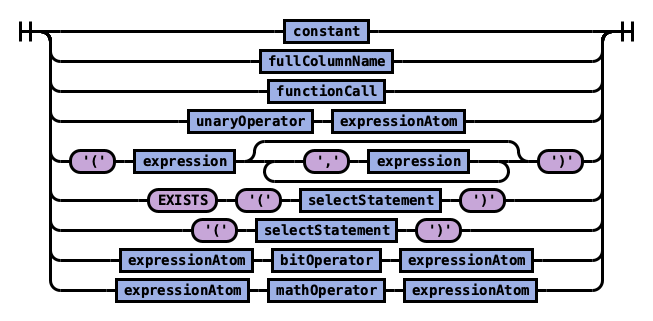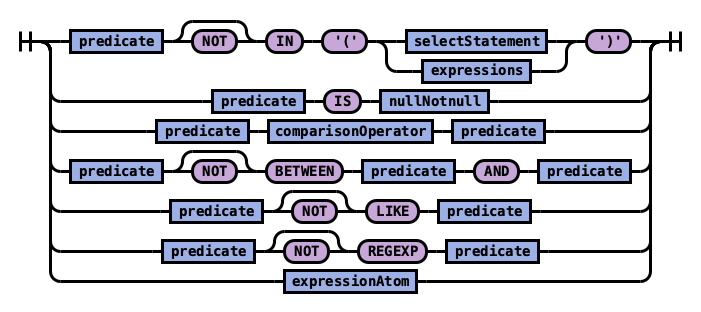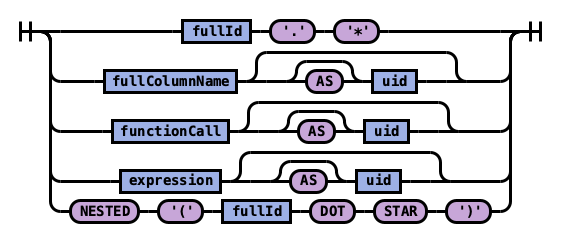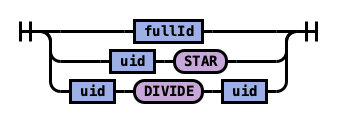Basic queries
Use the SELECT clause, along with FROM, WHERE, GROUP BY, HAVING, ORDER BY, and LIMIT to search and aggregate data.
Among these clauses, SELECT and FROM are required, as they specify which fields to retrieve and which indexes to retrieve them from. All other clauses are optional. Use them according to your needs.
Syntax
The complete syntax for searching and aggregating data is as follows:
SELECT [DISTINCT] (* | expression) [[AS] alias] [, ...]
FROM index_name
[WHERE predicates]
[GROUP BY expression [, ...]
[HAVING predicates]]
[ORDER BY expression [IS [NOT] NULL] [ASC | DESC] [, ...]]
[LIMIT [offset, ] size]
Fundamentals
Apart from the predefined keywords of SQL, the most basic elements are literal and identifiers. A literal is a numeric, string, date or boolean constant. An identifier is an OpenSearch index or field name. With arithmetic operators and SQL functions, use literals and identifiers to build complex expressions.
Rule expressionAtom:

The expression in turn can be combined into a predicate with logical operator. Use a predicate in the WHERE and HAVING clause to filter out data by specific conditions.
Rule expression:

Rule predicate:

Execution Order
These SQL clauses execute in an order different from how they appear:
FROM index
WHERE predicates
GROUP BY expressions
HAVING predicates
SELECT expressions
ORDER BY expressions
LIMIT size
Select
Specify the fields to be retrieved.
Syntax
Rule selectElements:

Rule selectElement:

Example 1: Use * to retrieve all fields in an index:
SELECT *
FROM accounts
| account_number | firstname | gender | city | balance | employer | state | address | lastname | age | |
|---|---|---|---|---|---|---|---|---|---|---|
| 1 | Amber | M | Brogan | 39225 | Pyrami | IL | amberduke@pyrami.com | 880 Holmes Lane | Duke | 32 |
| 16 | Hattie | M | Dante | 5686 | Netagy | TN | hattiebond@netagy.com | 671 Bristol Street | Bond | 36 |
| 13 | Nanette | F | Nogal | 32838 | Quility | VA | nanettebates@quility.com | 789 Madison Street | Bates | 28 |
| 18 | Dale | M | Orick | 4180 | MD | daleadams@boink.com | 467 Hutchinson Court | Adams | 33 |
Example 2: Use field name(s) to retrieve only specific fields:
SELECT firstname, lastname
FROM accounts
| firstname | lastname |
|---|---|
| Amber | Duke |
| Hattie | Bond |
| Nanette | Bates |
| Dale | Adams |
Example 3: Use field aliases instead of field names. Field aliases are used to make field names more readable:
SELECT account_number AS num
FROM accounts
| num :— | 1 | 6 | 13 | 18
Example 4: Use the DISTINCT clause to get back only unique field values. You can specify one or more field names:
SELECT DISTINCT age
FROM accounts
| age :— | 28 | 32 | 33 | 36
From
Specify the index that you want search. You can specify subqueries within the FROM clause.
Syntax
Rule tableName:

Example 1: Use index aliases to query across indexes. To learn about index aliases, see Index Alias. In this sample query, acc is an alias for the accounts index:
SELECT account_number, accounts.age
FROM accounts
or
SELECT account_number, acc.age
FROM accounts acc
| account_number | age |
|---|---|
| 1 | 32 |
| 6 | 36 |
| 13 | 28 |
| 18 | 33 |
Example 2: Use index patterns to query indexes that match a specific pattern:
SELECT account_number
FROM account*
| account_number :— | 1 | 6 | 13 | 18
Where
Specify a condition to filter the results.
| Operators | Behavior |
|---|---|
= | Equal to. |
<> | Not equal to. |
> | Greater than. |
< | Less than. |
>= | Greater than or equal to. |
<= | Less than or equal to. |
IN | Specify multiple OR operators. |
BETWEEN | Similar to a range query. For more information about range queries, see Range query. |
LIKE | Use for full-text search. For more information about full-text queries, see Full-text queries. |
IS NULL | Check if the field value is NULL. |
IS NOT NULL | Check if the field value is NOT NULL. |
Combine comparison operators (=, <>, >, >=, <, <=) with boolean operators NOT, AND, or OR to build more complex expressions.
Example 1: Use comparison operators for numbers, strings, or dates:
SELECT account_number
FROM accounts
WHERE account_number = 1
| account_number |
|---|
| 1 |
Example 2: OpenSearch allows for flexible schema,so documents in an index may have different fields. Use IS NULL or IS NOT NULL to retrieve only missing fields or existing fields. OpenSearch does not differentiate between missing fields and fields explicitly set to NULL:
SELECT account_number, employer
FROM accounts
WHERE employer IS NULL
| account_number | employer |
|---|---|
| 18 |
Example 3: Deletes a document that satisfies the predicates in the WHERE clause:
DELETE FROM accounts
WHERE age > 30
Group By
Group documents with the same field value into buckets.
Example 1: Group by fields:
SELECT age
FROM accounts
GROUP BY age
| id | age |
|---|---|
| 0 | 28 |
| 1 | 32 |
| 2 | 33 |
| 3 | 36 |
Example 2: Group by field alias:
SELECT account_number AS num
FROM accounts
GROUP BY num
| id | num |
|---|---|
| 0 | 1 |
| 1 | 6 |
| 2 | 13 |
| 3 | 18 |
Example 4: Use scalar functions in the GROUP BY clause:
SELECT ABS(age) AS a
FROM accounts
GROUP BY ABS(age)
| id | a |
|---|---|
| 0 | 28.0 |
| 1 | 32.0 |
| 2 | 33.0 |
| 3 | 36.0 |
Having
Use the HAVING clause to aggregate inside each bucket based on aggregation functions (COUNT, AVG, SUM, MIN, and MAX). The HAVING clause filters results from the GROUP BY clause:
Example 1:
SELECT age, MAX(balance)
FROM accounts
GROUP BY age HAVING MIN(balance) > 10000
| id | age | MAX (balance) |
|---|---|---|
| 0 | 28 | 32838 |
| 1 | 32 | 39225 |
Order By
Use the ORDER BY clause to sort results into your desired order.
Example 1: Use ORDER BY to sort by ascending or descending order. Besides regular field names, using ordinal, alias, or scalar functions are supported:
SELECT account_number
FROM accounts
ORDER BY account_number DESC
| account_number |
|---|
| 18 |
| 13 |
| 6 |
| 1 |
Example 2: Specify if documents with missing fields are to be put at the beginning or at the end of the results. The default behavior of OpenSearch is to return nulls or missing fields at the end. To push them before non-nulls, use the IS NOT NULL operator:
SELECT employer
FROM accounts
ORDER BY employer IS NOT NULL
| employer |
|---|
| Netagy |
| Pyrami |
| Quility |
Limit
Specify the maximum number of documents that you want to retrieve. Used to prevent fetching large amounts of data into memory.
Example 1: If you pass in a single argument, it’s mapped to the size parameter in OpenSearch and the from parameter is set to 0.
SELECT account_number
FROM accounts
ORDER BY account_number LIMIT 1
| account_number |
|---|
| 1 |
Example 2: If you pass in two arguments, the first is mapped to the from parameter and the second to the size parameter in OpenSearch. You can use this for simple pagination for small indexes, as it’s inefficient for large indexes. Use ORDER BY to ensure the same order between pages:
SELECT account_number
FROM accounts
ORDER BY account_number LIMIT 1, 1
| account_number |
|---|
| 6 |